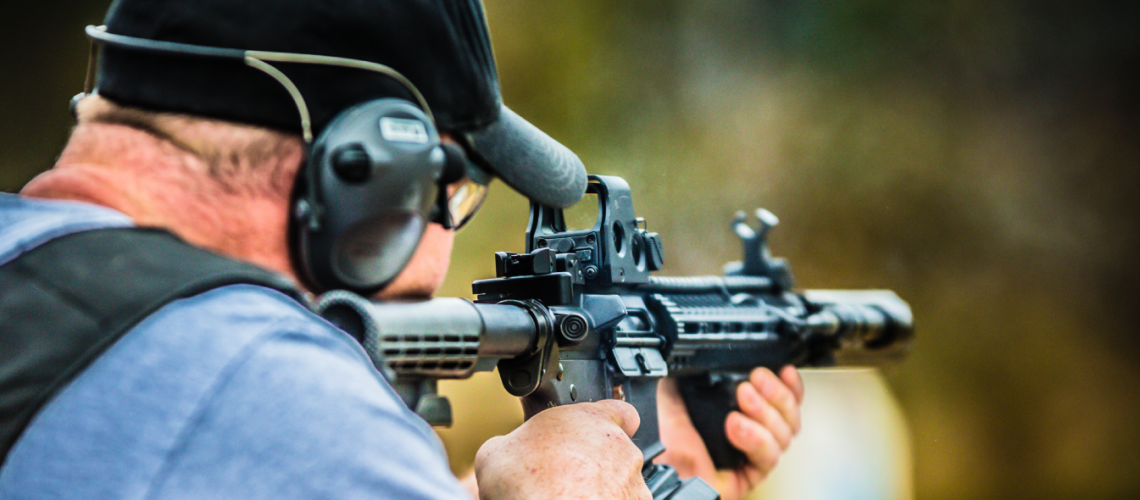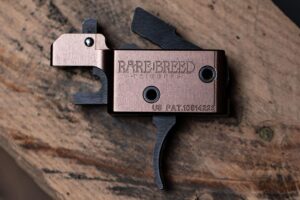We tend to focus on serious topics like home defense and concealed carry or even tips to purchase a firearm but it’s good to remember there are fun, safe, and legal activities you can partake in from being a firearm owner. Well, what if we told you that a particular kind of drop-in replacement trigger allows you to simulate full-auto fire in a semiautomatic weapon, without crossing into confusing and expensive NFA territory? These devices are generally referred to as binary triggers. Some of you may already know of Binary triggers and even may have used one before but let’s refresh exactly what it is and does.
Do you like shooting your semiautomatic firearm rapidly? A binary trigger is a replacement trigger that features two modes of firing, semiautomatic and binary or “echo” in the case of one brand. This binary trigger mechanism allows the user to fire whenever you pull the trigger and then to fire again with the release the trigger. This effectively allows shooters to double the round count that coming from the gun with the same amount of effort and trigger pull speed. This is different than a machine gun that fires multiple rounds when the trigger is pulled and held.
There is one obvious predicament: shooters may want the option to NOT have the second round go off once you release the trigger in binary mode. Do you have to hold the trigger back indefinitely until you can safely shoot again? This is a valid thought and one that was solved by the design of the safety selector. You can control whether you want to be in safety, fire (semi), or binary with the turn of a switch. So, if you decide you don’t want to be in the binary mode after you pull the trigger, you can change the mode right before you release the trigger, and this will stop that second round from being sent downrange.
The breakdown of the binary trigger is all in the actions of pressing and releasing the trigger. The first action of the binary trigger works similarly to the action of a standard trigger; when pulled, the sear “breaks” (two sharp metal edges the are normally held together rotate just enough to release) to release the hammer, which then strikes the firing pin. Once you have fired, the action cycles (typically through direct gas impingement or a gas piston, depending on firearm model) and resets the hammer. The disconnector holds the trigger in the rearward position to prevent automatic fire. Then once you release the trigger the sear then “breaks” again to release the hammer, sending the second shot down range. It is important to identify that there are two separate actions of the trigger taking place, both initiated by the user so that there is no automatic fire. While this does allow users to shoot faster, there is no defined cyclic rate of this type of system, as it is still depended on the rate at which the shooter pulls the trigger. Just like driving a car faster, shooting faster can be a lot of fun, and something many people tend to enjoy at the shooting range.
Are Binary Triggers Legal?
There are other trigger modifications (suck as lightning links or drop in auto-sears) that have been considered to be illegal machine guns because they can be used to convert a standard semi-automatic weapon to full-auto fire.
The ATF currently does not consider a binary trigger (or a firearm with a binary trigger installed) to be a machine gun because by law a machine gun is considered “any weapon which shoots, is designed to shoot, or can be readily restored to shoot, automatically more than one shot without manual reloading, by a single function of the trigger.” This essentially means you have multiple rounds sent downrange per each pull or action of the trigger, so since a binary trigger uses two actions to fire two shots, this is not by definition a machine gun. Federally, these are legal. Some states/counties have more stringent laws. More and more pressure is being placed on regulating these devices and effectively setting the equivalent of a speed limit for firearms. This is similar to our previous discussion on bump stocks (click here to read that article). Just because it is legal does not mean it is the best option for self-defense. Make sure to check your state and local laws so you can make sure you in possession a legal attachment for your firearm.

Who Makes Binary Triggers?
Franklin Armory
Franklin Armory, started this trend and is a leading manufacturer. They sell complete AR builds with the binary trigger component already installed, straight from the factory. They have a convenient red sticker that will help indicate your mode which is safe, fire (semi), and binary. They are known for their Binary Firing System (BFS). Franklin Armory manufactures triggers for a wide range of weapons and also sell the BFS package that includes everything you need to set up a binary trigger on your own AR-15.
Fostech
Fostech is probably the second most popular, the difference between the two designs is minimal but still should be noted. In a Fostech design, you will notice more resistance on the pull, which will lead to less push on the release, so the trigger pull is going to be a bit different and cause for a slightly slower speed. Fostech specializes in making triggers for only AR platforms, and the assembly is slightly different than the Franklin Armory package. This all is based on personal choice, like any trigger or accessory.
Photo Credit: Fostech
Rare Breed Triggers
The forced reset trigger (FRT) is going to give you a similar action to a binary trigger, but technically is not quite the same. Unlike a “shoot on pull” and “shoot on release” action, this design is always “shoot on pull” but the action to the trigger forces the trigger to reset itself with minimal travel. You will still get a similar action to allow you to shoot a lot faster than most would normally be able to. This drop in assembly for the ar-15 rifle achieves this when the hammer becomes re-cocked and then forces the trigger forward into your finger, but there are pieces to your gun that you will need to consider tunning in order for the forced reset trigger to work properly. For instance, you will possibly need a heavier buffer for your carbine, and you will need a full-auto or m16 bolt carrier. This all being said, back in July, the ATF did classify the Rare Breed FRT are machine guns. But this rule has changed law-abiding citizens into criminals overnight, so how did Rare Breed take this? Of course, Rare Breed has involved their attorney and filed a suit against the ATF. This is still an ongoing legal battle with Rare Breed presenting evidence that, under the NFA and the GCA the FRT is not classified as a machine gun. You can watch the video on their main page of their attorney general explaining this: Rare Breed Triggers FRT – Legal
This is further complicated by the Hughes amendment that has prohibits the manufacture of machine guns since 1986. This means that there is no legal path (such as paying for a stamp and registering a device) to make this a legal project, if in fact it is ruled to be a machine gun. We’ll stay vigilant in looking for a conclusion to this case. Many gun control advocates do not want a definite conclusion and are hoping the risk and the vague nature of this scares more manufacturers and gun owners from standing up for the Forced Reset Trigger.
UPDATE NOVEMBER 2021
This case was “Dismissed without prejudice”, basically meaning the case was thrown out, and a judgment was not issued in either party’s favor.
The Court ruled: “Absent supporting factual evidence, the Court may disregard the conclusory statements in the affidavit.”
Read more about this update in this article from AmmoLand: Rare Breed Triggers FRT

Overview
So, once really breaking down how a binary trigger works and the reasonings for getting one, is it really necessary? I would have to say it may not be necessary and not all gun owners find a practical use for it, but it sure is an absolute blast if you ever wanted to experience a full-auto at the range, and drop tons of brass on the floor.


